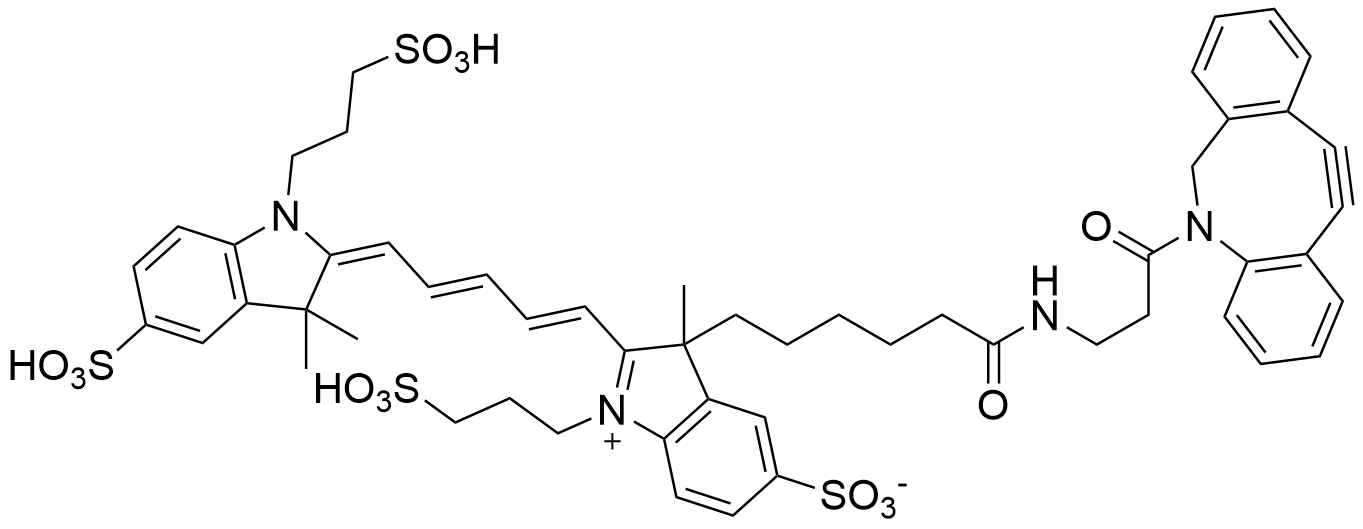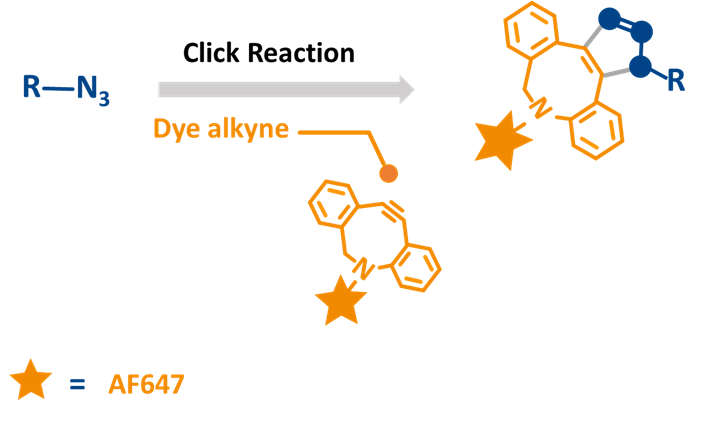DBCO-AF647
Dye to label by SPAAC in copper-free environment

| Size | Catalog No. | Price |
|---|---|---|
| 1 mg | BCFA-243-1 | € 200,00 |
| 5 mg | BCFA-243-5 | € 650,00 |
Chemical Properties
-
Molecular Formula
C55H62N4O14S4
-
Shelf Life
12 months unopened after receipt
-
Storage Conditions
-20 °C, dark
-
Molecular Weight
1117.33 g/mol
-
Purity
≥ 95% (HPLC)
-
Physical State
blue solid
-
CAS Number
n.a.
-
Excitation (max)
648 nm
-
Emission (max)
671 nm
-
Ɛ (max)
270.000 cm-1M-1
-
Solubility
H2O, DMSO, DMF
-
Preparation/Handling
For a 10 mM solution add 89.5 μL to 1 mg.
For a 10 mM solution add 447.5 μL to 5 mg.
Product Information
Far-Red Dye for Copper-Free Click Chemistry
DBCO-AF647 is a high-performance far-red fluorescent dye designed for bioorthogonal labeling via strain-promoted azide–alkyne cycloaddition (SPAAC). This copper-free click reaction eliminates the need for Cu(I) catalysis or heat, making it ideal for live-cell imaging and reactions in sensitive biological systems.
Why Choose DBCO-AF647?
- Rapid, selective conjugation: Highly reactive DBCO group forms stable triazole linkages with azides.
- Multiplex compatibility: Does not cross-react with tetrazines, enabling use alongside TCO-based systems.
- Bright far-red signal: Excitation 648 nm / Emission 671 nm for deep-tissue imaging and minimal background.
- Water-soluble & pH-stable: Maintains integrity across pH 4–10.
- Low autofluorescence: Long-wavelength emission reduces sample interference.
- High photostability: Supports long-term, high-resolution imaging.
- Platform-ready: Spectrally like Cy5, Alexa Fluor® 647, CF® 647, drop-in compatibility with existing setups.

Applications of DBCO-AF647
- Fluorescence microscopy: Live-cell, fixed samples, and whole-organism imaging.
- Flow cytometry: Compatible with standard red laser lines for multiparametric analysis.
- Bioorthogonal labeling: Copper-free tagging of proteins, peptides, antibodies, and azide-modified oligonucleotides.
- Bioconjugation: Amine-reactive functionality for covalent attachment to biomolecules.
- Tissue imaging: Clear signal even in high-autofluorescence environments.
Technical Specs
- Excitation / Emission: 648 nm / 671 nm
- Solubility: Water-soluble
- pH Stability: 4–10
- Photostability: High
- Format: Reactive dye with DBCO group
Complementary Products:
baseclick also offers a comprehensive portfolio of azide-containing dyes for click chemistry applications, including:
LITERATURE
Chemoselective Bioconjugation of Amyloidogenic Protein Antigens to PEGylated Microspheres Enables Detection of α-Synuclein Autoantibodies in Human Plasma, P. Ge et al., 2022, Bioconjugate Chemistry, Vol. 33(2), p. 301-310.
https://doi.org/10.1021/acs.bioconjchem.1c00530
FAQ
-
What is DBCO-AF647 used for?
DBCO-AF647 is a far-red fluorescent dye for copper-free click chemistry (SPAAC). It enables selective labeling of azide-containing biomolecules in live cells, fixed samples, and tissues without Cu(I) catalysis.
-
How does DBCO-AF647 differ from azide dyes?
DBCO-AF647 carries a dibenzocyclooctyne (DBCO) group, which reacts with azides via SPAAC. Azide dyes require a complementary alkyne or DBCO partner for conjugation.
-
Is copper-free click chemistry safer for cells?
Yes. SPAAC avoids Cu(I) catalysts and heat, making it non-toxic and suitable for delicate biological systems, including live-cell imaging.
-
What are the excitation and emission wavelengths?
Excitation: 648 nm
Emission: 671 nm
This far-red range minimizes autofluorescence and supports deep-tissue imaging.
-
Is DBCO-AF647 compatible with Alexa Fluor® 647 or Cy5 filters?
Yes. It shares spectral properties with Cy5, Alexa Fluor® 647, CF® 647, and other cyanine5-based dyes, so it works with standard filter sets and red laser lines.
-
Can I use DBCO-AF647 for multiplex labeling?
Absolutely. It does not react with tetrazines, so it’s compatible with TCO-based systems for orthogonal labeling strategies.
-
How stable is the dye?
DBCO-AF647 is water-soluble, stable across pH 4–10, and highly photostable—ideal for long-term imaging experiments.
-
What biomolecules can I label?
Proteins, peptides, antibodies, and azide-modified oligonucleotides. It also supports amine-reactive conjugation for covalent attachment.
-
How should I store DBCO-AF647?
Store at −20 °C, protected from light. Avoid repeated freeze-thaw cycles.
-
Does baseclick offer complementary azide dyes?
Yes. Options include Eterneon-Red 645 Azide, AZDye 647 Azide Plus, and Eterneon-Red 645-Picolyl-Azide.

